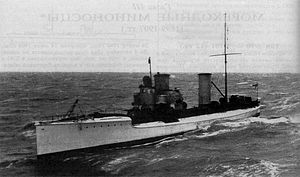SMS S90

| |
| History | |
|---|---|
| Name | SMS S90 |
| Builder | Elbing |
| Launched | 26 July 1899 |
| Completed | 24 October 1899 |
| Fate | Ran aground and wrecked 17 October 1914 |
| General characteristics | |
| Class and type | S90-class torpedo boat |
| Displacement | 388 t (382 long tons) design |
| Length | 63.0 m (206 ft 8 in) o/a |
| Beam | 7.0 m (23 ft 0 in) |
| Draught | 2.23 m (7 ft 4 in) |
| Installed power | 5,900 PS (5,800 ihp; 4,300 kW) |
| Propulsion |
|
| Speed | 26.5 kn (30.5 mph; 49.1 km/h) |
| Armament |
|
SMS S90, completing in 1899.
At the start of the
Design and construction
From the mid 1880s, the Imperial German Navy built up a large force of torpedo boats, while building a few larger "Division Boats" to lead the torpedo boat flotillas. From 1898, work began on a new class of larger torpedo boats, the
An initial group of 12 of the new large torpedo boats (S90–S101) were built by the
S90, the lead ship of the class, was

S90 was 63.0 metres (206 ft 8 in) long
Three coal-fired
Armament consisted of three 5.0 cm (2.0 in) SK L/40 guns, with two mounted side-by-side forward and one aft. Three single 45 cm torpedo tubes were fitted, with one in the gap between the ship's forecastle and the bridge, and two aft. Two spare torpedoes could be carried.[5][3][4] The ship had a crew of 50 officers and other ranks.[5]
Service
S90, together with sister ships S91 and S92, was sent out to China in the company of the hospital ship Gera in 1900 in order to reinforce the German East Asiatic Squadron as a result of the ongoing Boxer Rebellion.[6][7][8] S91 and S92 returned to Germany in the company of the cruiser Kaiserin Augusta in 1902.[9]
At the outbreak of the
Japan declared war on Germany on 23 August 1914,
Notes
- Seiner Majestät Schiff" (transl. His Majesty's Ship)
- ^ The "S" in S90 denoted the shipbuilder who constructed her, in this case Schichau.[1]
- ^ A total of 130 tons could be carried if stored in the engine rooms as well as the ship's coal bunkers. This would give rise to stability problems, however.[5]
Citations
- ^ a b Gardiner & Gray 1985, p. 164
- ^ Chesneau & Kolesnik 1979, pp. 262, 265
- ^ a b Chesneau & Kolesnik 1979, pp. 264–265
- ^ a b c d e Gröner, Jung & Maass 1983, pp. 42–43
- ^ a b c d e Friedman 2009, p. 88
- ^ "Warships for China". The Singapore Free Press and Mercantile Advertiser. 20 September 1900. p. 11. Retrieved 2 June 2023 – via NewspaperSG.
- ^ "Shipping News". Straits Budget. 20 September 1900. p. 7. Retrieved 2 June 2023 – via NewspaperSG.
- ^ Hildebrand, Röhr & Steinmetz 1980, p. 124
- ^ Hildebrand, Röhr & Steinmetz 1986, p. 12
- ^ Naval Staff Monograph No. 16 1922, pp. 35–38
- ^ Halpern 1994, p. 71
- ^ Raeder 1922, p. 12
- ^ Naval Staff Monograph No. 16 1922, p. 49
- ^ Corbett 1920, p. 149
- ^ Naval Staff Monograph No. 16 1922, p. 52
- ^ Halpern 1994, p. 74
- ^ "Interned German Crew: Escape and Recapture". The Singleton Argus. 3 November 1914. p. 2.
References
- Chesneau, Roger; Kolesnik, Eugene M., eds. (1979). Conway's All The World's Fighting Ships 1860–1905. London: Conway Maritime Press. ISBN 0-85177-133-5.
- Corbett, Julian S. (1920). Naval Operations: Volume I: To the Battle of the Falklands December 1914. History of the Great War: Based on Official Documents. London: Longmans Green & Co.
- Friedman, Norman (2009). British Destroyers: From Earliest Days to the Second World War. Barnsley, UK: Seaforth Publishing. ISBN 978-1-84832-049-9.
- Gardiner, Robert; Gray, Randal, eds. (1985). Conway's All The World's Fighting Ships 1906–1921. London: Conway Maritime Press. ISBN 0-85177-245-5.
- Gröner, Erich; Jung, Dieter; Maass, Martin (1983). Die deutschen Kriegsschiffe 1815–1945: Band 2: Torpedoboote, Zerstörer, Schnellboote, Minensuchboote, Minenräumboote (in German). Koblenz: Bernard & Graef Verlag. ISBN 3-7637-4801-6.
- Halpern, Paul G. (1994). A Naval History of World War I. London: UCL Press. ISBN 1-85728-498-4.
- Hildebrand, Hans H.; Röhr, Albert; Steinmetz, Hans-Otto (1980). Die Deutschen Kriegsschiffe: Biographien – ein Spiegel der Marinegeschichte von 1815 bis zur Gegenwart : Band 2 (in German). Herford, Germany: Koelers Verlagsgesellschaft mBH. ISBN 3-7822-0210-4.
- Hildebrand, Hans H.; Röhr, Albert; Steinmetz, Hans-Otto (1986). Die Deutschen Kriegsschiffe: Biographien – ein Spiegel der Marinegeschichte von 1815 bis zur Gegenwart : Band 4 (in German). Herford, Germany: Koelers Verlagsgesellschaft mBH. ISBN 3-7822-0382-8.
- Monograph No. 16: The China Squadron, 1914, Including the Emden Hunt (PDF). Naval Staff Monographs (Historical). Vol. V. The Eastern Squadrons, 1914. Naval Staff, Training and Staff Duties Division. 1922. pp. 17–116.
- Raeder, E. (1922). Der Kreuzerkrieg in den ausländischen Gewässen: Erster Band: Das Kreuzergeschwader. Der Kreig zur See. Berlin: Verlag von E. S. Mittler & Sohn.
